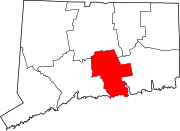Middle Haddam, Connecticut
Description and history
Middle Haddam was settled in the 17th century as part of Middletown, and was incorporated as part of East Hampton in 1767. From an early date it was a shipbuilding community, with a sawmill on Mill Brook, which runs through the village. By the early 18th century, a ferry service was operating across the Connecticut River. By the time of the American Revolution, it was a small but significant commercial center for a large agricultural area to the east, and became the locus of a road network serving those areas. It also acted as a shipment point for trade with the West Indies and the North American coast, and was the site of shipyards building ocean-going vessels.
The village and historic district are shaped by the local topography. The river forms the boundary to the west, and the inland boundaries are generally the result of steep slopes along the river bank or of the streams that pass through the area. The village's northern boundary is distinguished by a transition to later industrial development of Cobalt village, and to the south by a wooded open space and a more widely spaced development pattern. The district has 58 historically significant primary buildings, most of which were built before 1835, giving the village a distinctly Federal style. Its oldest buildings date to 1732. There is only one example of Queen Anne Victorian architecture, built as a summer residence near the town landing.
Among others, the Princeton and Yale Divinity School-educated Second Great Awakening evangelist James Brainerd Taylor (1801–1829) was born in Middle Haddam's historic district. As a boy, Taylor attended the town's still-standing Christ Episcopal Church (est. 1786).
See also
References
- ^ "National Register Information System". National Register of Historic Places. National Park Service. March 13, 2009.
- ^ "NRHP nomination for Middle Haddam Historic District". National Park Service. Retrieved November 26, 2014.
